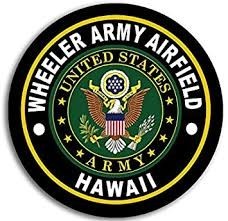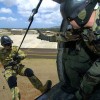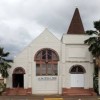Geography and Area Information
Wheeler Army Airfield lies at 21°29′12″N 158°02′38″W 20 miles outside of Honolulu Hawaii. The facility covers 207,858 acres (325mi2) in the center of the Island of Oahu. A Wheeler Army Airfields' northern border is marked by the intersection of Kunia Road and Wilikina Drive while the southern border falls just north of Waikele Stream. The eastern border is marked by the State Highway 99, the Kamehameha Highway, and the western by Kunia Road. The region surrounding Wheeler Army Airfield is largely residential with a majority of the population being somehow related to the military. The Wahiawa District where the facility is located is in a low-lying area of the island with higher elevation “mountainous” areas to the east and west. The entire island of Oahu is in a tropical zone and experiences warm humid temperatures year-round in addition to substantial rainfall.
History
Wheeler Army Airfield was established in 1922 with a small detachment of 20 enlisted men from Luke Field. This small working party was tasked with clearing the area, building housing and erecting two canvas hangers in the flying field. The area was officially christened Wheeler Field on November 11, 1922, after the late commander of Luke Field, Major Sheldon H. Wheeler who was killed when his DH-4B crashed on Ford Island the previous year. In June of 1923, the pace of construction quickened and oil storage tanks, a new flying field, shop hangers, and new airplane hangars were all constructed. Despite this expansion in construction, it wouldn’t be until 1930 that any permanent structures were erected at Wheeler Field.
Due to the climate and ability for year-round training Wheeler Field was a popular area for aviation training and several units were cycled in and out of or stationed at the base in the 1920’s and 30’s. This included the 17th Composite Group, 19th Pursuit Squadron, 18th Pursuit Group, 15th Pursuit Group, and the 14th Pursuit Wing. The original units of Wheeler Field were Branch Intelligence Office No. 11, Photo Section No. 11 and the 4th Observation Squadron.
During the pre-World War II era, Wheeler Field played a pivotal role in the transformation of aviation history bearing witness to multiple historical events. This included the 1927 first mainland to Hawaii nonstop flight, the 1928 trans-pacific flight from Australia to the United States, the 1935 solo Hawaii to mainland flight by Amelia Earhart, and several subsequent visits by the famed female pilot.
Just a few years before United States involvement in World War II Wheeler Field had transitioned into the primary base for Army Air Corps pursuit aircraft, the first generation of real fighter planes like the P-40 Warhawk and P-36 Hawk. This garrison of aircraft was tasked with patrolling the skies around the Island and its air defense and played a major role in the attack on Pearl Harbor.
The United States Air Force was established as a separate service in 1947 and Wheeler Army Airfield was redesignated as Wheeler Air Force Base and command turned over to the newly formed Department of the Air Force. As Wheeler Air Force Base the installation would be moved from a non-active maintenance status and then back to full capacity with the outbreak of the Korean War conflict. Wheeler Air Force Base would be home to several logistical and support units in the 1950’60’s and ’70s with the longest lasting and most prominent being the 15th Air Base Squadron. The 15th Air Base Squadron took on the role of supplying all munitions, maintenance, and logistical support to Air Force activities and missions in the Hawaiian Islands area. This included operating small arms firing range that was used for qualification and training purposes by local law enforcement, US Customs, and military personnel. From early 1960 to the late 1980s Wheeler Air Force base played host to many Army and Air Force air components including fixed and rotary-wing units of the Army and the United States Air Force support and forward control units flying the O-2 Skymaster and OV-10 Bronco.




